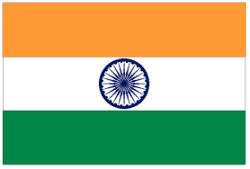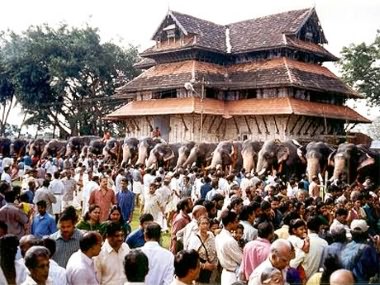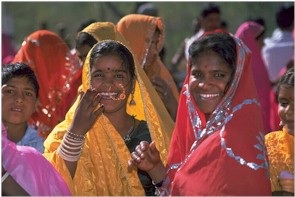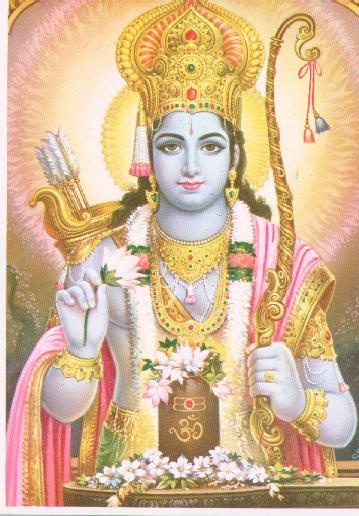
The Flag of India
There are certain moments in the cultural and political life of a nation when the national flag comes into notibility. Every Indian is aware that the Prime Minister unfurls the national tricolor from the ramparts of the Red Fort every Independance Day on August 15, and indeed, the observance of January 26th as Republic Day goes back to December 31, 1929, when Jawaharlal Nehru hoisted the flag of the Indian National Congress, gave a call for Purna Swaraj, and asked people to observe January 26th as Independance Day.
Along with the national anthem, the national flag is a large expression of India. It is supremely and specialy iconic of the nation-state. It is understood that the honor and integrity of the nation captured byt the flag, and as the history of every country shows, the national flag is uniquely capable of enlisting the aid of citizens, giving rise to sentiments of nationalism, and evoking the supreme sacrifice of death. In every respect, the national flag commands allegiance.
Most Indians, in the past, were forbidden under the pain of punishment to fly the national flag from the premises of their residential or office building. The present flag is the flag Mahatma Gandhi lent his hand in design. Congress adopted it in 1921. Two years after the massacre at Jallianwala Bagh, Gandhi observed that the red in the flag represented Hindus, the green stood for Muslims, and the white represented other faiths. The spinning wheel in the middle of the flag pointed to the oppressed condition of every Indian, just as it evoked the possibility of rejuvenating every Indian household. Gandhi didn't think the matter of the national flag was trifling. A famous quote from Gandhi was, "A flag is a necessity for all nations. Millions have died for it. It is no doubt a kind of idolatry which it would be a sin to destroy."

Gandhi's flag, as it was known to English officials, was with some modifications formally adopted by the Congress in 1931 as the National Flag, and this flag in turn became the basis, with the substitution of the wheel on the capital of Asoka's Sarnath Pillar for the charkha, for the National Flag chosen by the Constituent Assembly in July 1947. Between 1921 and 1947, a war of attrition developed between Indian nationalists and government officials over the right to fly the Gandhi or Congress flag. Indian nationalists found that hoisting the flag invariably attrackted the wrath, and often the vengeance, of British officials, and usually the flag was ordered to be brought down.
All too often the national flag in most countries has not been the pivot around which sentiments not merely of nationalism but of jingoism, hatred, and racial exclusivism have been fostered. One can only hope that the Indians will prevail upon themselves to display a more judicious and restrained attitude towards the flag. There may also well be a time, in the very near future, when the Indian parliament and judiciary will have to deliberate in an altogether different manner on the status of the flag. Is the burning of the National Flag protected under the Constitution as an expression of free speech, or must such an act invariably be constituted as an offense punishable under law? In the cultural and political semiotics of nationhood, the National Flag is bound to occupy an increasingly important place. 
What is the national anthem of India?
" Jana Gana Mana Adhinayaka Jaya He
Bharat Bhagya Vidhata
Punjab Sindh Gujarat Maratha
Dravida Utkala Banga
Vindhya Himachal Yamuna Ganga
Ucchala Jaladhi Tiranga
Tubh Shubha Name Jage
Tubh Shubha Ashisha Mange
Gahe Tubh Jaya Gata
Jan Gan Mangaldayak Jay He
Bharat Bhagya Vidhata
Jaye He ! Jaye He ! Jaye He !
Jaye,Jaye,Jaye,Jaye He "
The India's national anthem was first sung on December 27, 1911 at
the Indian National Congress. The Constituent Assembly adopted the song of
National Anthem of India on January 24, 1950. The anthem consists of five
stanzas.
English translation
" Thou art the rulers of the minds of all people
Dispenser of India's destiny
Thy name souses the hearts of
Punjab, Sind, Gujarat, and Maratha
Of the Dravida and Orissa and Bengal
It echos in the hills of
The Vindhyas and Himalayas,
Mingles in the music of the Yamuna and Ganga
And is chanted by the waves of the Indian Sea.
They pray for thy blessings and sing thy praise.
The saving of all people waits in thy hand,
Thou dispenser of India's destiny.
Victory, victory, victory, to thee."
What is India's religion?

India's major religion is Hinduism, which is approximately 80% of the population. Hinduism is one of the largest religion in Asia with one of the oldest faiths. Hinduism has several holy books, and they believe in reincarnations and spiritual salvation. During the process of reincarnation there is a factor of moving closer to eventual enlightenment. Hindu's don't believe in convention, you are either born a Hindu, or you're not.
Hindus view cosmic activity of the Supreme Being as comprised of three tasks: creation, preservation, and dissolution and recreation. Hindus associate these three cosmic tasks with the three deities, Brahma, Vishnu and Shiva. Lord Brahma brings forth the creation and represents the creative principle of the Supreme Being. Lord Vishnu maintains the universe and represents the eternal principle of preservation. Lord Shiva represents the principle of dissolution and recreation. These three deities together form the Hindu Trinity.
Hindu religion is often labeled as a religion of 330 million gods. According to the Hindu scriptures, living beings are not apart from God, since He lives in each and every one of them in the form of atman (BG 10.39). The number 330 million was simply used to give a symbolic expression to the fundamental Hindu doctrine that God lives in the hearts of all living beings.
Hinduism is supposed to be 'apauruseya', i.e., of impersonal origin & so also are the Gods of Hinduism. They are eternal & though the deities appear to be different & independent, they are really facets of the same Brahman, the Supreme God.
As Sri Ramakrishna says, there can be as many spiritual paths as there are spiritual aspirants & similarly there can really be as many Gods as there are devotees to suit the moods, feelings, emotions & social background of the devotees.
The Hindu scriptures were eloquent while describing the qualities of God. He is all-knowing & all powerful. He is the very personification of justice, love & beauty. He is ever ready to shower His grace, mercy & blessings on His creation.
BRAHMA


Within the hindu trinity of Brahma, Vishnu and Shiva, Brahma is the creator, Vishnu the preserver and Shiva the destroyer. Nevertheless, Brahma grew in a lotus out of the navel of the sleeping Vishnu. The daily alternation of light and dark is attributed to the activity of Brahma.
Brahma's mind born sons are the seers Marici, Atri, Angiras, Pulastya, Pulaha, Kratuj, Pracetas, Vashishta, Bhrgu and Narada. From Brahma's body came his nine sons Daksa, Dharma, Kama, Anger, Greed, Delusion (Maya), Lust, Joy, Death and Bharata and one daughter called Angaja.
In order to create the world and produce the human race, Brahma made a goddess out of himself. One half was woman and the other half was man. Brahma called the woman Gayatri, but she also became known by many other names such as Saraswati.
Brahma has four heads, but used to have five. The four extra heads appeared when Gayatri was very ashamed with Brahma's love for her and tried to escape from his gaze. The tremendous tapas that Brahma had practiced for the purpose of creation was entirely annihilated through his desire to unite with his daughter. One head was lost later when Brahma lied to Vishnu and thus caused Shiva to become very angry.
The four Veda's are said to have sprung from his heads. In the Life of Ganga, Brahma advised Bhagiratha to ask the help of Shiva in containing the power of Ganga (goddess of the Ganges river).
HANUMANA


Hanuman is the monkey deity renowned for his courage, power and faithful, selfless service. The Life of Hanuman is related below in the form of short numbered and illustrated accounts of some of the most important parts of his life.
Some say Hanuman was born as the son of the King and Queen of the Monkeys. To others, he is the son of Anjana, an female Apsara who had been transformed into a monkey by a curse, and Vayu, the wind god. It is also said that from his father Vayu Hanuman received the ability to fly.
As soon as Hanuman was born he felt hungry and his mother could not satisfy him. Then he caught sight of the Sun and thinking it was a fruit he leapt after it. The Sun took flight but Hanuman chased him as far as Indra's heaven. Here however, Indra intervened and injured Hanuman's jaw with his thunderbolt.
But his father was quick to avenge him and entered the bodies of all gods and gave them colic. Indra apologized to Vayu and agreed that Hanuman should become immortal. All the gods came together to bless young Hanuman in a cave.
As a young monkey god, Hanuman was quite naughty and abused his powers to pester the saints living in the nearby forest. On this painting Hanuman can be seen creating a whirlwind with his breath, drinking offered water, pulling a supporting stick with his tail, pulling a beard and dousing a sacred fire.
Finally all the gods prayed to Brahma to find a solution. Thus a curse was created to protect the world from the mischief that young Hanuman created, by removing his knowledge of his powers.
The Power of Hanuman - of which becoming big is just one example - only became available again when Jambavant, King of the bears, remembered Hanuman that he has that power.
And that power was really great. Hanuman could easily fight an elephant for example, since he could become much bigger than the elephant at will.
At the time of the Ramayana, Hanuman was send as an advance spy to Lanka. To reach the island he had to fly over the sea but there was blocked by Sursa, who wanted to test him. She had a boon that everybody who comes before her must pass through her mouth. However, when she wanted to swallow Hanuman, he became bigger and bigger so she also had to become bigger and bigger. Then Hanuman suddenly became very small and went in through her ear, coming out of her mouth, thus fulfilling the boon.
In the Ashokvatika or forest of Ashoka trees on Lanka, Hanuman spies on Ravana, who is trying in vain to press Sita into becoming his wife. Later he contacted Sita in the gardens of Ravana's palace, told her of the plans being made for her deliverance and gave her Rama's signet ring as a token.
Pleased with his succes, Hanuman fought the demon Meghnaath, son of Ravana, in the gardens of the palace of Lanka. He won over Meghnaath, but was finally captured by Ravana's demons.
Brought before the demon king, Ravana ordered that while as a messenger of Rama he could not be killed, his tail could be set afire with cloth and oil. But Hanuman used his powers to enlarge his tail indefinitely, untill the demons had no cloth left to cover it. While they still tried to put fire to his tail, Hanuman became suddenly very small and escaped from his ropes.
Trailing his burning tail behind him, Hanuman then set fire to all of Lanka and flew back to the mainland. He rejoined Rama and gave him valuable information on Ravana's forces. The army crossed a bridge to Lanka that was made by another monkey leader and master architect called Nala.
During the mighty battle that followed, Hanuman defeated the Demon Lankini, who was the principal guard of the city of Lanka.
Hanuman's greatest feat during the battle of Lanka however was to bring back the herb that cured Lakshman from a fatal wound. He flew al the way to the Himalayas to find it, harassed by many demons, such as Kalanemi. Because Indra was confusing him, Hanuman could not find the herb and finally brought the entire mountain to Lanka.
Ravana was defeated by Ram and Ram and Sita were crowned King and Queen of Ayodhya. Obviously Hanuman was present, remained Ram's favorite general and continued his life in service to him. When Rama offered him any boon that he cared to name, he asked to live for as long as men spoke of the deeds of Rama.
LORD KRISHNA


Lord Krishna appeared over five thousand years ago in Mathura, India to Devaki and Vasudeva in the jail cell of the tyrant Kamsa. The place of His birth is known as Sri Krishna Janmasthana. He appeared with His brother Balarama in response to the demigods' prayers for protection from the widespread influence of demonic administration on earth.
Previously, the demigods and demons had been at war in the heavens. When the demons were defeated by the demigods, they decided to instead attack this planet earth. Thus, they invaded the earth by discretely taking birth as princes in powerful royal families of the time.
And as the earth became overrun by militaristic activities of these kingly demons, the demigods including the Earth goddess earnestly sought Lord Visnu's protection. Seeing the deteriorating social and political conditions and hearing the prayers of the demigods, the all-compassionate Supreme Lord Sri Krishna decided to descend for the benefit of all.
The Supreme Lord descends from time to time in this material world to reestablish the teachings of the Vedas. In His Bhagavad-gita, Lord Krishna promises: "Whenever and wherever there is a decline in religious practice, O descendant of Bharata, and a predominant rise of irreligion--at that time I descend Myself. To deliver the pious and to annihilate the miscreants, as well as to reestablish the principles of religion, I Myself appear milleniumm after millenium."
Although eternal the Lord appears in specific circumstances out of mercy for His devotees. In fact, His principal biography, the Srimad Bhagavatam states, "the learned men describe the births and activities of the Unborn and Inactive." Therefore, although He appears within the material dimensions of time and space, He is most definitely not of it.
Historically, Lord Krishna appeared on the midnight of the 8th day of the dark half of the month of Sravana. This corresponds to July 19th 3228 BC. He exhibited His pastimes for a little over 125 years and dissappeared on February 18th 3102 BC on the new moon night of Phalguna. (His departure marks the beginning of the current age of corruption known as Kali.)
The great scholar Srila Vishvanatha Chakravarti neatly outlines Lord Krishna's activities in this way: the first three years and four months were spent in Gokula, then equal lengths of time in Vmdavana and Nandagram, eighteen years and four months in Mathura, and finally ninety-six years and eight months in Dvaraka totalling 125 years of manifest pastimes. See the Krishna-lila chart.
Lord Krishna's early pastimes are briefly summarized at the website Krishna's Adventures in Vraja"During this childhood time , He grew up as the son of His foster parents Nanda and Yasoda in the midst of the idyllic beauty of Gokula, Vrindavana, and Nandagram. Not only did He destroy numerous demons, but also performed His famous rasa dance.
Krishna enjoyed the dance of love (rasa-lila) with the gopis many of whom are expansions of His own internal energies. The supreme gopi known as Srimati Radharani is the object of Krishna's highest devotion. This beautiful dance would occur in the autumn season at night under a full moon when Lord Krsna would captivate the young gopis with the extraordinary music of His flute . These esoteric pastimes constitute the most confidential expression of divinity ever revealed.
Usually the conception of sprirtual perfection consists of overwhelming feelings only of awe and reverence at God's majesty. However, in these pastimes each devotee loves God either as a master, a best freind, a mischievous son, or even as an intimate lover, thus revealing the infinite possibilities of divine love. These early pastimes of Lord Krsna in Vrindavana illustrate the extraordinary intimacy that one can have with God. These pastimes are described in detail by Sri Visvantha Chakravarti in his Sri Krishna Bhavanamrta Mahakavya
When Krsna and Balarama were older, They were invited to Mathura, where Karnsa, Their demonic uncle, was planning Their death in a wrestling match against two large and powerful wrestlers. When Kamsa saw his wrestlers defeated, he ordered his friends to drive the brothers out of Mathura, plunder the riches of Their cowherd friends, and kill Their fathers, Nanda and Vasudeva. However, Krishna immediately killed Kamsa and Balarama killed his eight brothers. Lord Krishna then established the pious King Ugrasena as the emperor of several kingdoms.
In Mathura, both Krishna and Balarama were initiated by Gargamuni in the Gayatri mantra> Later They went to live under the care of Sandipani Muni who instructed Them in all the Vedic arts and sciences in sixty-four days and nights especially in military science, politics and spirituality. As an offering (guru-daksina) to Their teacher, They recovered his son from death. Although God does not need instruction from anyone else, Lord Krsna and His brother set the perfect example : one must accept instruction from and serve a bona-fide spiritual master to advance in spiritual life.
For the next eighteen years, They continued to live in Mathura halting the impending threat of many demonic kings. Later in Their pastimes Lord Balarama married a princess named Revati. Lord Krsna married many queens, the foremost among them being the extraordinarily beautiftil Queen Rukmini. (See Sri Rukmini website for the story of Their marriage). Both Krishna and Balarama established Their palaces in Dvaraka off the coast of western India, where They enjoyed married life for many years. Although They were married, Lord Krsna and Lord Balarama exhibited the quality of detachment from material life perfectly.
When They were about ninety years old, the great world war of Kuruksetra took place. This climactic battle brought together all the major world leaders. Lord Krsna took the role of a charioteer on the side of the pious Pandavas, while Lord Balarama refusing to participate went on a pilgrimage tour thereby blessing the entire land of India.
At the start of the war, Lord Krishna displayed His stupendous Universal Form delivered His famous message known as the Bhagavad-gita, literally the Song of God. This Song contains the essence of all knowledge having been spoken by the Supreme Lord Sri Krishna Himself. This war concluded with the destruction of the demonic kings and the reinstatement of the righteous Pandava princes.
Having completed Their mission, Balarama and Krsna resumed Their life in Dvaraka where They spent some thirty-five more years before ending Their earthly manifest activities The foremost description of Lord Krishna's activities occurs in the Srimad Bhagavatam, literally "the Beautiful Book of God."